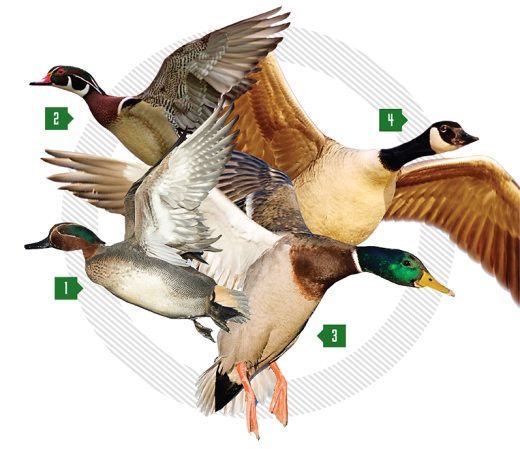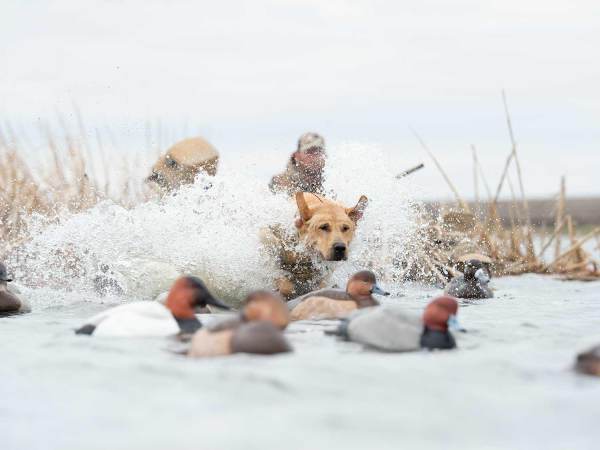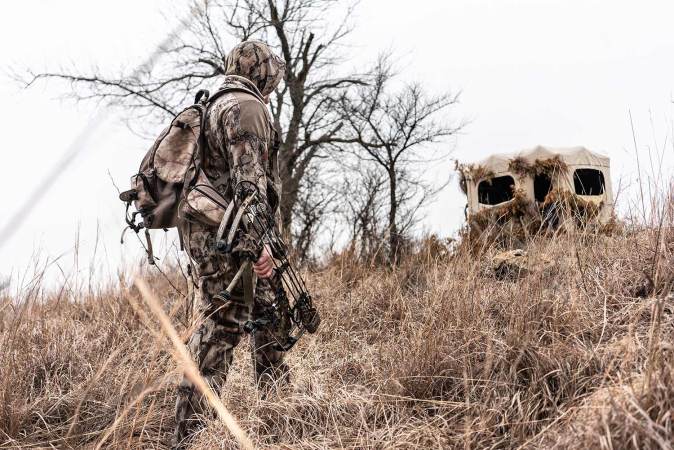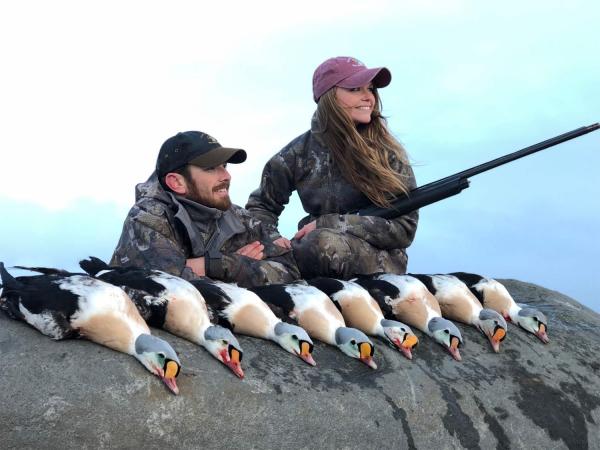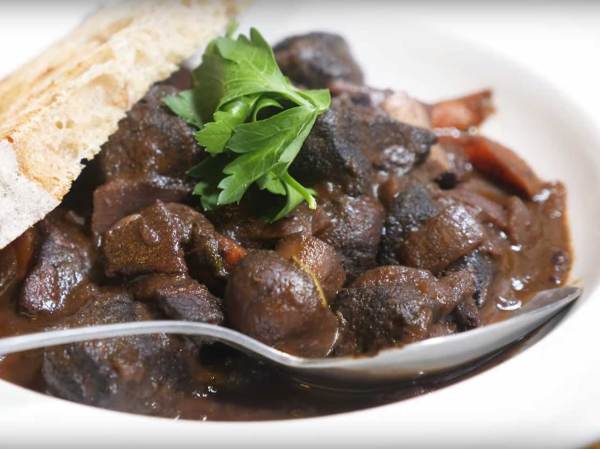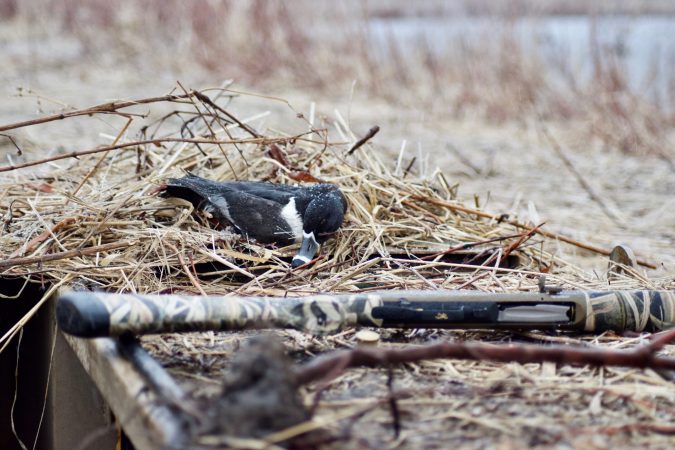We’re crouched below the plywood walls of the pontoon blind and can see three scoters gliding into shooting range. Someone whispers, “Take ‘em,” and we drop two with a quick volley. High-fives make their rounds, and the game is on.
For the first few flights, we remain silent, still, and hidden as shooters on the ends call the shots, but it doesn’t take long before we become as emboldened as the ducks, which begin dive bombing our spread. Sea ducks are about as tough as the arctic winters they evolved to endure, and you, and the guy next to you, often have to give them every shot in the gun to put them down.

“With these ducks, you have to really make sure they’re dead, or they will dive underwater and pop back up out of range,” says Sierra Langbell, one of the hunters in the crew.
Our boat blind was packed with a handful of photographers and media folk for the last leg of Beretta’s torture tour for their new A400 Xtreme Plus shotgun. The plan was to hunt sea ducks on Tilghman Island, Maryland and to explore the rich waterfowling culture of the Chesapeake Bay.

The shooting formed a cacophony, with the guns barking together—at times sounding as if we had only fired a single shot. At one point, I looked over to see Aaron Hitchins of the production company, Rockhouse Motion, yelling like William Wallace at the head of a charge, “Take it to the plug!” while frantically stuffing more shells down the tube as music bumped from his phone.
This was the first time I’d ever hunted sea ducks, and I was by far the worst shooter of the bunch. After a particularly embarrassing volley, I asked for some pointers.
“The challenge is how they fly,” says Justin Leesemann, one of my blind mates, “low on the water, and fast.”
Which was a kind way of explaining that I was behind the birds. Sam Soholt, a talented photographer, tells me to, “Give them about half a canoe length,”—a unit of measure I will certainly reference in the future—and I finally started connecting.
With a handful of birds down, the boat came by and grabbed them with a long-handled net before motoring away again.

SALT LIFE
Wade Murphy met our group at the dock at 5:45 a.m. sharp, and we hauled our gear onto his 40-ft Chesapeake Bay deadrise emblazoned with the name “Elle’s Angels”—offering a hint to his dry humor. A deadrise is a style of boat that is popular, if not exclusive to the region and characterized by a sharp V-shaped bow that becomes much flatter bottomed towards the stern.This keeps the vessel stable at slow speeds for tasks like dredging oysters or pulling crab traps.
Murphy is a waterman, and he splits his time between guiding duck hunters, oystering, crabbing, and anything else he can do to scrape a living from the salt. He’s all business and takes his job with Barneck Outfitters seriously. Murphy doesn’t get behind the gun too much himself, but he’ll be the first to tell you that the Chesapeake is a waterfowler’s dream. From the moment you cross over the Chesapeake Bay Bridge, you’re immersed in a deep history of waterfowling—from the layout boats rolling down the highway to the fowl-themed paintings, wallpaper, and decoys that festoon everything from the smallest gas station to the most popular crab shack.

But, don’t let this cultural enthusiasm hide the fact that not everything is ducky.
Between hunting pressure and environmental issues, the Bay has had a rough go of it. While the punt gun mounted on the mantle of the local dive is a welcome reminder of the end of a darker era, the Chesapeake is still in the process of recovery. Water quality reached a nadir in the 1970s, causing a significant decline in the number of wintering birds and abundance of staple sea life such as crabs and oysters which are vital to the local economy and culture. With an average depth of only 21 feet, the bay is surprisingly shallow, making it a prime location for sea ducks to wait out the winter with easy access to vegetation and mollusks, their preferred forage. As water quality declined, many flocks of birds left for better wintering grounds, and some locals followed suit.
Watermen like Murphy weren’t the first to draw a living from the Chesapeake—first were the Paleo-Indians, followed by the Spanish, then the English. Some wealthy English royalists, such as the Calvert Family, were given governance of vast holdings in the “New World,” and Cecilius Calvert named his family’s colony “Terra Maria,” or “Maryland” to honor King Charles I’s wife, Queen Henrietta Maria.
With many plantations and the slave economy disbanded at the end of the American Civil War, the distribution of wealth in the region changed radically, and the local economy shifted focus from agriculture to a greater reliance on oystering and fishing. Many looked to the Bay for sustenance, both literal and spiritual, which holds true to this day in the deep maritime culture of the region.
Murphy has watched the health of the Bay ebb and flow over the last 30 years of working the water and knows first-hand what’s at stake. With the uncertain future of the Bay and increased cost of living, he has diversified his income with construction and other land jobs.
“I’ve been out here on the water since I was 13 doing everything there is to do, and I’m 47 now, so it’s been a long time,” Murphy says.
While numerous independent recovery efforts have prevented a true disaster, no approach has been altogether holistic. Thankfully, due to the signing of the Chesapeake Bay Watershed Agreement in 2014, a multi-state collaborative commitment to the restoration and conservation of the region, there is a cause for hope. As we passed the rafts of ducks feeding in the Bay and signs for $1 oysters, the hope seemed to be well founded.

BUFFLEHEAD BEATDOWN
A square shape emerged from the darkness and Murphy pulled up alongside the floating blind. Grabbing the anchor rope with a gaff, he pulled the blind a few hundred yards to a new position where we unloaded. Murphy made laps around us, setting long strings of decoys—scoters, buffleheads, and longtails—about 30-yards off the blind. Once he had finished, he moved a few hundred yards away and stayed in contact via walkie-talkie. The half dozen of us were packed into the blind like sardines, and we loaded our Berettas with 3-inch #2’s while the group joked and sipped coffee in the waking light. As the sun began to rise, we could make out the silhouette of the island taking shape about a mile or so behind us. Tilghman Island, where we were hunting, was first known as Great Choptank Island, but it became the property of Matthew Tilghman—a fiery figure in Maryland’s revolutionary efforts against the British—and has worn his namesake ever since.
“You get more birds when it’s colder and when there’s ice on the water and nowhere for them to land, but it’s so warm and there’s no ice so we’ll just have to see,” Murphy tells us before leaving the blind.
We didn’t have to wait long to find out, as a group of buffleheads came soaring in and crumpled to our shots. These ducks are small and speedy, but we managed to drop a one-man limit within the first few passes. They mostly came in small groups of three or so, and the group slowly swung from one side of the blind to the other, like a contra dance with shotguns.
“They’re coming around again,” someone says, and the guns wasted no time in responding.
We were having so much fun that I asked Murphy about the logistics of a hunt like this when he pulled up to the blind to check in.
“It can be tough to do this kind of hunt without an outfitter,” he says. “The whole shoreline is like a lottery for blind sites, and landowners get first dibs on licensing their shorelines. But, it’s doable if you have a boat that can get out past the high tide mark where it becomes open to the public.”
We limited out within a few hours and headed to shore to unwind. It was a “bufflehead beatdown” as Brad Heidel of Delta Waterfowl so eloquently put it, but there were a few surf scoters mixed in. With some celebratory beers, we got to work on the birds.
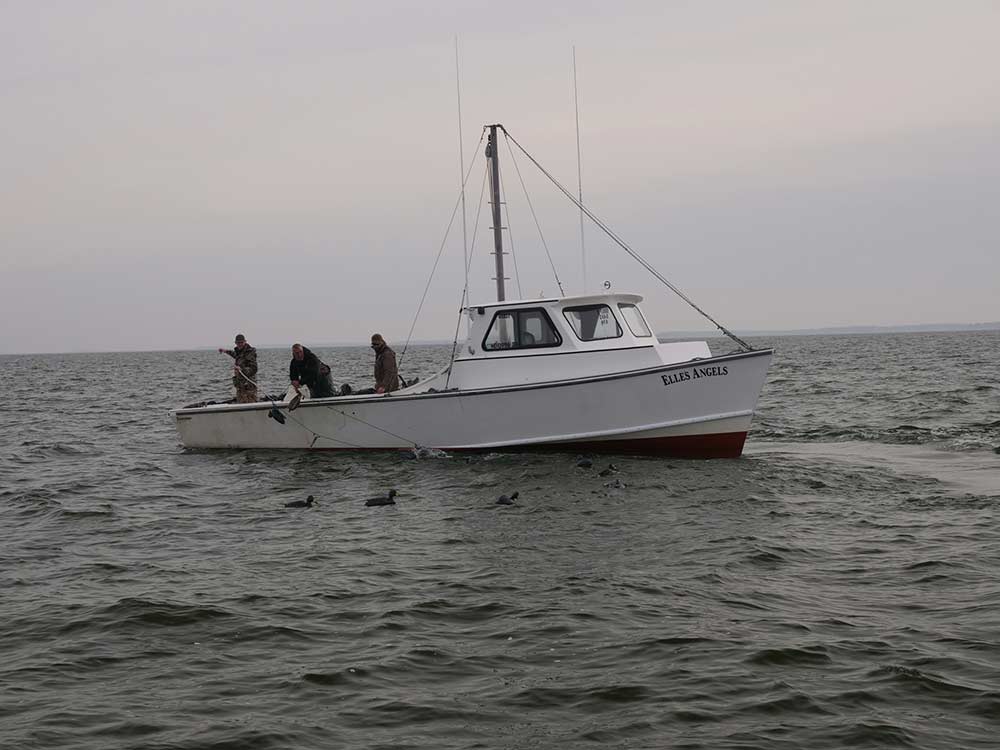
After processing the ducks and a much-needed nap, we hit the local towns. Everywhere we went, we met friendly folks who all had a hunting story to tell or a tidbit of history to share. One local told us how the Blackwater National Wildlife Refuge, to our south—which today, protects vital habitat for wildlife and is a renowned destination for hunters and anglers—once protected fleeing slaves as part of Harriet Tubman’s Underground Railroad.
They weren’t shy about recommending where we should eat, either, and eat we did. At every meal, we gorged ourselves on oysters, crabs and rockfish. If you’re ever in the area, take yourself a seat under the taxidermied goose at the Carpenter Street Saloon in St. Michaels, and order a Chesapeake club with fried rockfish and whatever the hell crab imperial is. Trust me.
We retired after a long night of laughing and indulging, ready for another action-packed morning. The second day started off much like the first, though we were a bit farther out to sea this time—roughly three miles out. We were set up nearly identically to the previous morning, though we encountered mostly black scoters this time. While the time between flights seemed to be a bit longer, the groups of birds were larger on average. Having shaken off any jitters the previous morning, the group was focused and efficient. That is, until one of the group members who had stayed on the main boat with Murphy unloaded on a decoy instead of the cripple he was after, and any sense of composure was lost in our hysterical laughter.
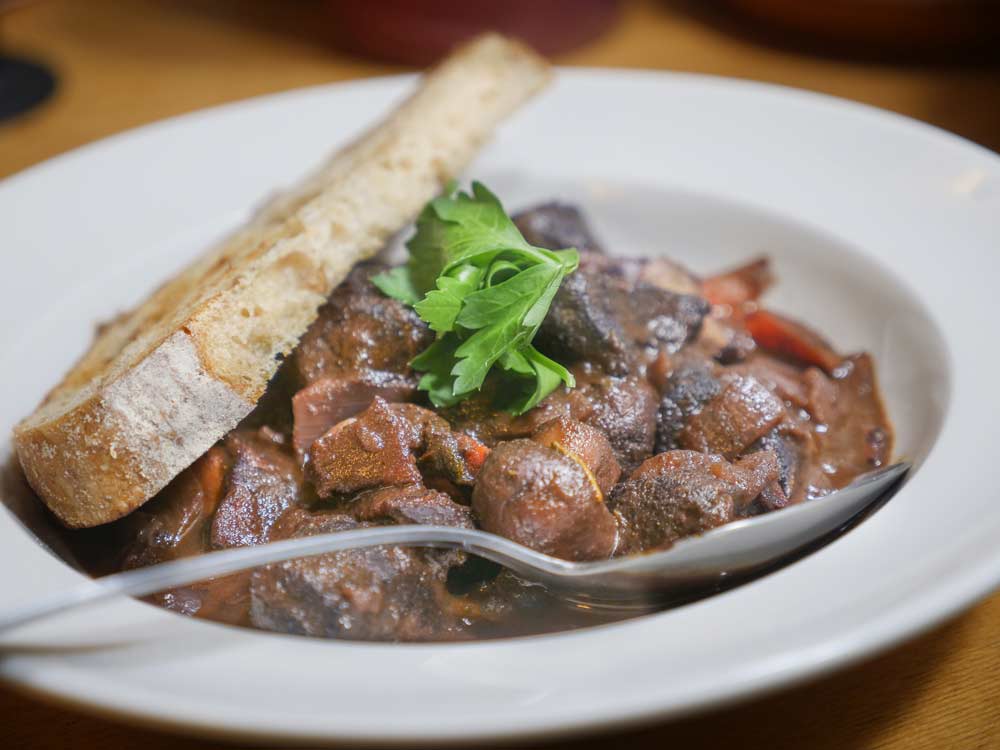
COOKING SEA DUCKS
Returning home was bittersweet, though a new adventure loomed. I called on my good friend Massoud, a talented chef, and we found a day to get together and experiment. We butchered the birds and noted that the meat was soft textured and livery, though neither the birds nor the meat smelled bad—even after spending three days stuffed into a cooler, whole. I would be lying if I said I was optimistic.
There’s not a lot of literature about cooking sea ducks, and what little there is doesn’t paint the most appetizing picture. Still, I tried to stay open-minded despite my doubts; all it takes is a few bad cooks to ruin the good name of an animal, condemning it to the jerky pile for generations. I was eager to prove the naysayers wrong.
Massoud and I sipped coffee and scratched ideas into his leather-bound notebook. At the store, we bought heavy, masking ingredients to produce recipes like sea duck curry, brined and fried duck nuggets, and pulled sea ducks smothered in BBQ sauce. Anything to make them taste like anything but what they were.
Read Next: How To Make Sea Duck Bacon Bombs
We also wanted to do our due diligence and decided to suffer through a plain, pan seared breast so that we knew what we were working with. With nothing but salt and pepper, we seared two breasts, one rare, and one cooked through. As they rested, we sliced thin pieces of the raw breast like a carpaccio. Then we ate.
We sat there staring at each other for what felt like several minutes.
Eventually, a “wow” escaped my lips.
Instead of fishy and gamey, it was meaty and mild. Instead of soft and mushy it was tender and textured. Had we served you a piece blindfolded you would have guessed you had been chewing on the inner tenderloin of a young deer before asking for more.
“Well, this changes everything,” says Massoud.

We went into a frenzy—knives chopping, pans clanking, fire flaming, and on the other side came out a beautiful sea duck bourguignon, confited legs, and rolled breasts stuffed with goat cheese and spinach and wrapped in bacon.
The two of us were elated, if not a little inebriated, and Massoud summoned his girlfriend from her studies to join the feast. We were eager to see if our sea ducks passed muster.
We watched her pensively as she sampled each dish.
“Wow,” she says, “this is really good.”









